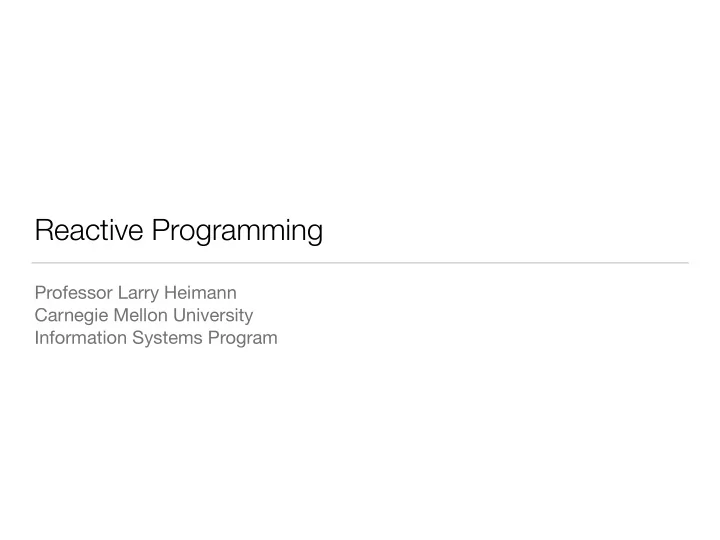

Reactive Programming Professor Larry Heimann Carnegie Mellon University Information Systems Program
API requirements in this sprint
Quick refresh: delegate pattern in iOS Five steps for setting up the delegate pattern between two objects, where object B is the delegate for object A, and object A will send out the messages: 1. Define a delegate protocol for object A; consider protocol extensions as appropriate. 2. Make object B conform to the delegate protocol. It should put the name of the protocol in its class line and implement the methods from the protocol. 3. Give object A an optional delegate variable. ( This variable should be weak. ) 4. Tell object A that object B is now its delegate. 5. Make object A send messages to its delegate when something interesting happens, such as the user pressing the Cancel or Done buttons, or when it needs a piece of information.
Simple Delegate example https://github.com/profh/67442_SimpleDelegate
“If you've ever used an asynchronous callback based API, you've probably dealt with handling the response data ad-hoc all across your codebase, and have most likely decided there was no way to unit test it all... But, let me tell you - there is a better way, and it's called Rx!” – Krunoslav Zaher, creator of RxSwift
Reactive programming defined “Reactive programming is a programming paradigm oriented around data flows and the propagation of change . This means that it should be possible to express static or dynamic data flows with ease in the programming languages used, and that the underlying execution model will automatically propagate changes through the data flow.”
What is reactive programming? • A responsive application is the goal. • A responsive application is both scalable and resilient . Responsiveness is impossible to achieve without both scalability and resilience. • A message-driven architecture is the foundation of scalable, resilient, and ultimately responsive systems.
At the core, the observer pattern • What is the observer pattern? • Allows other objects to observe events and get notifications when state changes. • Useful when state is regularly changing and/or many other objects need to know when state has changed
Review: simple Ruby example of observers
Reactive Programming in Swift • RxSwift can be found on GitHub: https://github.com/ ReactiveX/RxSwift • Materials from lectures drawn heavily from RxSwift book by Pillet, et al. • Strongly recommended for students wanting to learn more about reactive programming in general and RxSwift in particular • Same true for this week’s lab
Key to RxSwift: Observables The Observable<T> class provides the foundation of Rx code: the ability to asynchronously produce a sequence of events that can “carry” an immutable snapshot of data T . In the simplest words, it allows classes to subscribe for values emitted by another class over time. { Observer1 Observer2 Observer3 At its heart, an observable is just a sequence
Finite and infinite data streams Finite data streams include: • File downloads (file sent in parts as chunks of data) • GET requests from an API endpoint • Timers counting off increments of time Infinite data streams include: • Changing the device orientation • Tapping buttons
Simple examples of observables
Time to look at some code
Observable traits • Singles will emit either a .success(value) or .error event. .success(value) is actually a combination of the .next and .completed events. This is useful for one-time processes that will either succeed and yield a value or fail, such as downloading data or loading it from disk. • A Completable will only emit a .completed or .error event. It doesn't emit any value. You could use a completable when you only care that an operation completed successfully or failed, such as a file write. • And Maybe is a mashup of a Single and Completable. It can either emit a .success(value) , .completed , or .error . If you need to implement an operation that could either succeed or fail, and optionally return a value on success, then Maybe is your ticket.
More code…
Next key concept: Subjects A Subject is an object that can be both an observable and an observer. There are four types of subjects: • PublishSubject — starts empty and only emits new elements to subscribers. • BehaviorSubject — starts with an initial value and replays it or the latest element to new subscribers. • ReplaySubject — initialized with a buffer size and will maintain a buffer of elements up to that size and replay it to new subscribers. • Variable — wraps a BehaviorSubject, preserves its current value as state, and replays only the latest/initial value to new subscribers.
PublishSubjects The first subject emits three events and completes • The second subject subscribes after first event, but gets the other two • The third subject subscribes after the second event. First subject • notifies both observers of the last event
BehaviorSubjects The first subject emits three events and completes • The second subject subscribes after first event, but gets the first event • immediately and notified of the other events when they occur The third subject subscribes after the second event. It gets the prior • event immediately (but not the original) and other events when they occur
ReplaySubjects The first subject emits three events and completes and notifies the • second subject as they occur The third subject subscribes after the second event. It gets all the prior • events immediately and is notified of other events when they occur
Recommend
More recommend